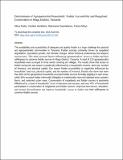Determinants of Agropastoralist Households’ Fodder Accessibility and Rangeland Conservation in Magu District, Tanzania

View/
Date
2022-03Author
Rustis, Glory
Hambloch, Caroline
Swamikannu, Nedumaran
Moyo, Francis
Metadata
Show full item recordAbstract
The availability and accessibility of adequate and quality fodder is a huge challenge for pastoral and agropastoralist communities in Tanzania. Fodder scarcity, primarily driven by rangeland degradation, population growth, and climatic changes, limits livestock productivity and deepens rural poverty. This study assessed factors influencing agropastoralists’ access to fodder and their willingness to conserve fodder sources in Magu District, Tanzania. A total of 210 agropastoralist households were surveyed in three wards covering six villages. The results show that access to fodder during the wet season is positively influenced by a household's income, land size, number of livestock, and physical capital. Dry season fodder accessibility is negatively influenced by households’ land size, physical capital, and the number of livestock. Results also show that more than 60% of the agropastoral households accessed fodder sources formally (legally) in open areas, while 35% accessed fodder informally (illegally) in traditionally reserved highland areas, people's farms, and restricted urban areas. Conservation of rangelands and fodder sources is positively influenced by a head of households’ level of education and income, and only 40% of households participated in conservation of rangelands and fodder sources. Improved land tenure, education, and income diversification can improve households’ access to fodder and their willingness to conserve fodder sources.
URI
https://doi.org/10.1016/j.rama.2022.11.005https://dspace.nm-aist.ac.tz/handle/20.500.12479/1837
